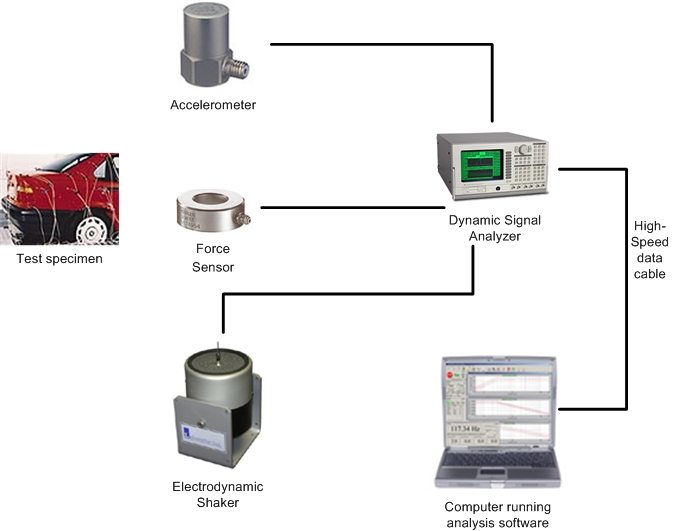AMAZON multi-meters discounts AMAZON oscilloscope discounts
Modal testing is a type of vibration testing. Using modal analysis allows an engineer to of a test specimen and determine its fundamental frequencies.
There are several different methods of performing modal testing. The most most common methods use impact hammers and shakers.
below: In this type of modal analysis setup, dynamic
characteristics of components and entire vehicles can be assessed. 
 Modal
Testing using Impact Hammer:
Modal
Testing using Impact Hammer:
When a test object is struck, it's said to be "excited" and will vibrate based on the spectral bandwidth of the impulse. While it vibrates, the object will act in a way such that that some of the frequencies will be suppressed (attenuated) while other frequencies will be amplified. The amplified frequencies -- resonant frequencies -- are known as the fundamental frequencies of that particular object. They are the modal frequencies.
 Modal
Testing using Shakers:
Modal
Testing using Shakers:
Shakers are tools that are used to "excite" the structure or test object based on the an amplified input signal. Modern shaker systems (and their controllers) offer input signals (test modes) suitable for modal testing. Sine-sweep and random-vibration are the most common test modes for this application.
A shaker's armature is attached to the body of the object to be tested -- usually this is done using piano wire (pulling force) or stinger (pushing force). When the signal is sent through the piano wire or the stinger, the object responds the same way as in impact testing -- by attenuating or amplifying certain frequencies. These frequencies are measured as modal frequencies.
How Modal Testing Works:
When the impact hammer or the shaker stinger is fitted with the device called a load cell (a type of "force sensor", as shown in first diagram), an engineer can measure the excitation signal. The response signal is acquired through an accelerometer attached to the test object. Comparing these two signals in the frequency domain (via calculating the transfer function), one can mathematically determine how the object moves or vibrates at modal frequencies. If sufficient measurement points are available, mode shapes of the object can be evaluated from the transfer functions.